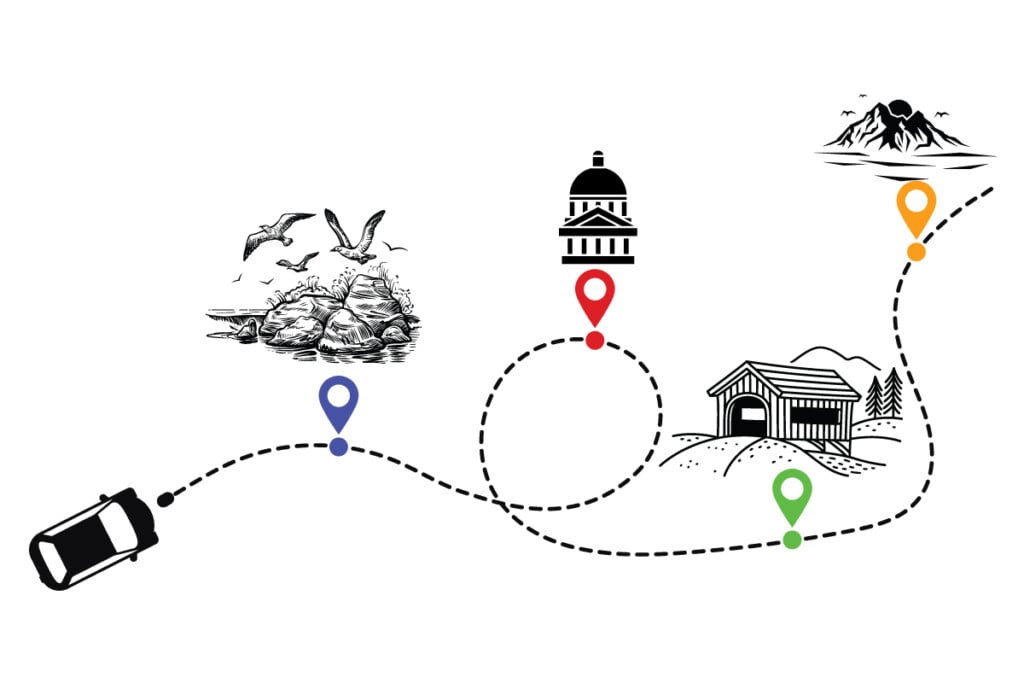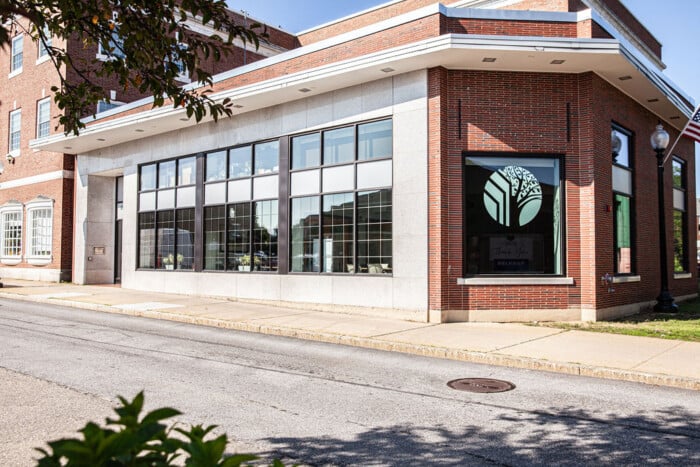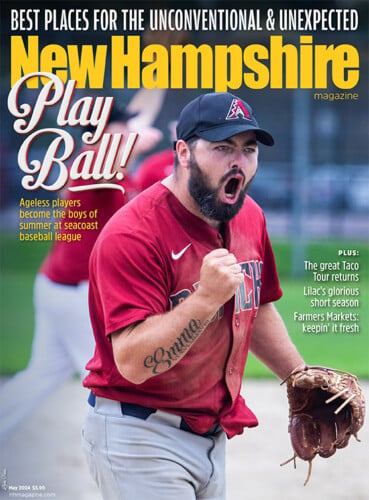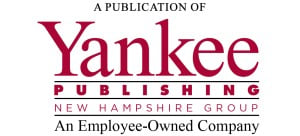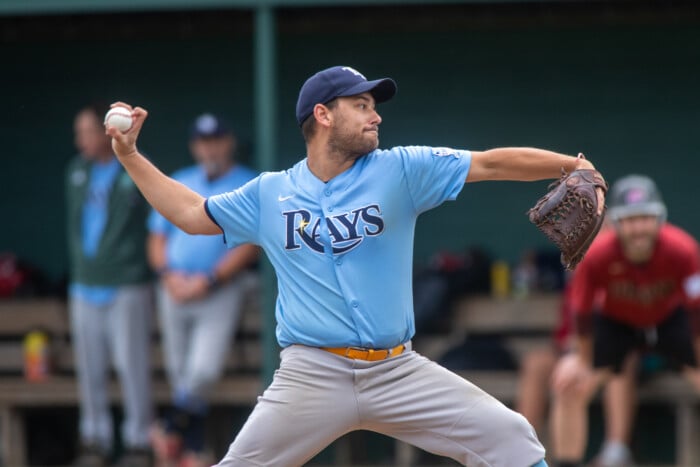Galloping to the Rescue
The animals that people love the most are often the ones most endangered by neglect or abuse. And when those animals weigh 1,000 pounds or more, the challenge to those who would save them becomes just as enormous.

Filmmaker Rebecca Howland with her adopted rescue horse, Neptune. Howland made a documentary about Live and Let Live Farm called “Voices in the Dark.” Read more about Howland and Neptune here. Photo by Chris Saunders
When Paul Revere accepted the mission to warn John Hancock, Samuel Adams and many of the original New England Patriots on the night of April 18, 1775, he traveled from Charlestown, Massachusetts, to Lexington astride a horse.
Accompanied by William Dawes and Samuel Prescott, history tells us that by the end of the night, there were 40 men riding together on horseback.
While it was recorded that Revere’s horse was borrowed, it is widely accepted that she was a Thoroughbred mare named Brown Beauty. Revere, who four months earlier rode on horseback to Portsmouth to warn the colonists, simply called her “a very good horse.”
She must have been. For there is no other type of animal that possesses the strength, speed, stamina, athleticism, agility, intelligence, courage and free spirit required to complete the arduous and dangerous journey that heralded the beginning of the American Revolution.
Although “The Midnight Ride of Paul Revere” was 244 years ago, horses of many breeds and all sizes have always been a vital part of the American economy, agriculture and culture at large. In the 21st century, they’re still an integral and important part of New Hampshire’s quality of life.
Moreover, for thousands of years, humans have both depended on horses and loved them. What little girl hasn’t dreamed of finding a pretty pony with colorful ribbons braided into its mane prancing next to her birthday cake? What young kid didn’t fantasize about growing up to be a cowboy or cowgirl, riding off into the sunset astride a faithful and trusty companion?
But sadly, there isn’t always a happy ending for these magnificent creatures.
Unlike dogs and cats, which are the other species with which we share a close emotional bond, horses are big and they are powerful. Big animals are a big responsibility, a big obligation and a big commitment, and that creates a powerful problem.
Those who run accredited 501(3)(C) nonprofit organizations in New Hampshire that rescue, rehabilitate, retrain — and hopefully — rehome horses report the problem only becomes bigger. Ever increasingly, they are confronted with an influx of abused, neglected, starving and/or abandoned horses that arrive from all parts of the state.

Live and Let Live Farm in Chichester, which cares for animals of all sorts, is one of three certified equine rescue agencies in New Hampshire. Photo by Rebecca Howland
These horses were either seized by state or local authorities who were notified, often anonymously, of animal cruelty, or they were surrendered voluntarily by an overwhelmed owner no longer able to provide for them.
“There are plenty of horses around that need help,” says Teresa Paradis, the founder of Live and Let Live Farm’s Rescue and Sanctuary in Chichester. And, she says, the need is only growing.
“In 2018, more than any other year, the state Department of Agriculture called us in at least once a month,” she adds. As of this past December, when this issue was going to press, Live and Let Live Farm was caring for 82 rescued horses of many different breeds.
“I tell them we’re already doing all we can do, but they say, ‘You know, Teresa, there’s nowhere else but you.’ I can’t say no,” she continues. “So there’s always another one coming in.”
Live and Let Live Farm, which also takes in and cares for a veritable menagerie of animals of all shapes and sizes, is one of three certified equine rescue agencies currently licensed by the New Hampshire Department of Agriculture, Food & Market’s Division of Animal Industry. The others are Hidden Pond Farm Equine Rescue in Brentwood and the Winchester-based Draft Gratitude, which specializes in helping the various noble draft breeds such as Clydesdales and Shires, known as gentle giants, weighing around 2,500 pounds each.
The New Hampshire ASPCA in Stratham, which was housing a total of 18 rescued horses and ponies at the end of 2018, is also an accredited facility, but technically hangs out the shingle as a pet adoption agency. No facility can be issued dual licenses concurrently, according to state officials.

Hidden Pond Farm Equine Rescue in Brentwood is another certified rescue organization. This is Maggie, Hidden Pond’s official greeter, a bundle of energy who makes everyone smile. Photo by Edie Freedman
The number of New Hampshire horses ending up in rescue centers is alarming. Nevertheless, they are fortunate indeed to be safe and with qualified and loving caretakers after being extricated from their previous situations, all of which were heartbreaking, unbearable and often unimaginable.
“It’s indescribable how truly horrible the conditions were that some of them were in,” says Phyllis Marie Elliott, Hidden Pond’s co-founder and owner, where she cares for 20 horses and ponies of various breeds.
“We see some very, very sad cases. It is heartbreaking. Absolutely,” says Carrie Fyfe, who is a veterinary technician and the equine manager at the NHSPCA’s main facility.
Why do so many end up in rescue? Humans have huge hearts when it comes to horses, but they don’t always have the bank balances to match. Money isn’t the only issue — there are a number of other resources necessary for proper horse care that many newcomers to the horse world don’t account for, including the significant time commitment.
Many don’t know what they don’t know when they become owners.
“Oh, dear God. They have no idea,” says Kathy Whedon of Loudon, who found a kindred soul in Lely, the now 19-year-old mare she purchased privately when the Thoroughbred was 3 years old and racing unsuccessfully at the now-defunct Rockingham Park in Salem.
“So many people want to have a horse but they don’t understand how much care they need, they don’t know how to properly take care of them, and they don’t even imagine how expensive that care is,” says Whedon, who boards Lely at Serenity Stables in Belmont, where the facilities are the equivalent of an equine four-star resort. “There is a huge time commitment there as well. Owning a horse is a lifelong commitment. My girl and I are together ’til death do us part.”
Unfortunately, not all horses are as lucky as Lely.
Too many of them are not provided with even the most basic of necessities, which include food, hay, fresh potable water, shelter and routine care from a veterinarian, horse dentist and farrier (blacksmith).
When it comes to shelter, if the owner doesn’t have a farm or suitable backyard facilities, the horse must be boarded. In 2018, monthly full boarding fees in New Hampshire ranged from $600 to $1,200, depending upon the quality of the stable and the services provided. Feed runs more than $100 per month, and that doesn’t include hay. Tack, blankets, straw or wood shavings for bedding, and equipment, such as heated water buckets, cost money. The veterinarians, horse dentists, farriers and other equine practitioners need to be paid in a timely manner, and on top of it all, there are always illnesses, accidents, and emergencies when it comes to horses.
The expenses are endless. So is the time required for daily stall mucking, bathing, grooming, feeding, watering and proper exercise. It’s easy to see how an owner can get overwhelmed and end up underwater.

Hidden Pond co-founder Phyllis Marie Elliott with Louise and her baby Maggie, who was born on the farm after Louise was rescued from a killpen in Pennsylvania. Maggie nearly died after she was born because she didn’t have the necessary antibodies for an effective immune system. Several transfusions (and many thousands of dollars later), she bounced back and today is healthy as can be. Photo by Edie Freedman
New Hampshire’s long, hard, cold winters only serve to exacerbate an already tough situation.
When there is no grass for grazing, owners who were already barely able to afford to feed their horses spiral down deeper into trouble. State law requires that as of November 1, all horses must have at least a three-sided shelter, but laws don’t guarantee that people will follow them.
“The winters are the toughest on the horses. No question,” says Paradis. “The ground freezes so they can’t graze naturally on grass, and they require more purchased grain and hay. Water also freezes, and they can’t access it so they get dehydrated. As the weather grows colder and the days get shorter, the bills climb higher,” she adds. “We get a lot of starvation cases. We’ve had some very hard cases and, tragically, we’ve lost a few horses.”
The Henneke horse body condition scoring system is a numerical scale used to evaluate the amount of fat on a horse’s body, and the mid-range of 5 to 6 is ideal. Paradis says that she’s taken in horses that are so emaciated they register only at 1.5, with 1 signifying the animal is dead. The longer the horse endured starvation, the more damage was done to internal organs, making the recovery process more difficult and costly, both physically and financially.
But there is immediate help available for any owner who cannot properly care for his or her animals. Those best qualified to provide that assistance are strongly encouraging anyone in this situation to follow the steps to end needless suffering. All the owner need do is pick up the phone and someone who can help will be on the other end.
“As soon as you get into trouble, please ask for help. Don’t wait,” says Fyfe. She adds that there are a number of resources in place, whether from the NHSPCA or another organization. Among other things, they can help with temporary issues, such as finding money to get through the winter.
“We have things in place and we can give you a hand, but we can’t help if we don’t know who you are and what you need,” says Fyfe. “The majority of the cases we see are people who do have their hearts in the right place, and they don’t mean any ill will for these horses, but for a variety of circumstances — from financial issues to their health to life circumstances — they don’t reach out for help until the situation is pretty far gone. We see that quite a bit.”
Often, says Paradis, people who otherwise care for their horses run into trouble, suddenly realizing they can no longer pay for food. If Paradis can’t take the horse in, they can offer a feed program where they supply enough food and hay to last for the winter until — if still needed — a spot opens up in the spring.
“These are people who have loved them and cared for them. We call it in-home rescue. But it’s still a horrible situation,” says Paradis.
For those horses requiring more than a stop-gap solution, voluntary surrender is the best solution. But it’s never an easy one, not for anyone involved.
“It’s tough to convince someone to give up their animal. It’s a fight,” says Paradis.
When the battle can’t be won, the animal control officers, cruelty investigators and other authorities step in and step up. “It’s really hard in New Hampshire,” says Paradis. “The state Department of Agriculture does not and cannot go in to help unless the town or city officials ask them for help.”


Steven was purchased at an auction in Pennsylvania. A former racehorse, Steven was left to starve (pictured in the the first photo). After several months of care at Hidden Pond, he was adopted (above is Steven today with Phyllis Marie Elliott). Photo by Edie Freedman
What the rescuers often run into is a situation where the owner is incapacitated in some way and, consequently, unable to do the right thing by the animal or make rational decisions.
Paradis remembers a tragic situation that occurred in Weare a few years ago.
“The animal control officer called me right before Christmas. She said there was an elderly woman who was an animal caretaker for other people, but she wasn’t even feeding her own horses. There was a Norwegian Fjord pony and a Shetland pony who had no water in the barn, and there was no path of footsteps in the snow going to the barn. The officer gave her a week and still no one went to the barn,” recalls Paradis.
“The officer went back and discovered that both ponies were living in deplorable conditions and were starved. They were both in the 1.5 category. The Fjord had very long fur and you could still see the hips and the spine, so you know they were really in trouble when we got them. The vet came and did the exam. Five days later, the Fjord collapsed, and we lost her. The other one we named Ranger and, thankfully, he made it.”
Though this was a terrible case of animal cruelty, Paradis did not want the woman arrested and prosecuted.
“When the police arrived all they could find in her house for human food was one jar of peanut butter. She had starved dogs living in filthy crates. I begged the Weare police not to arrest her and make this public. There was nothing to gain by bringing charges. But the agreement had to be made that she never have any more animals, and she had to go to live with her son. There are a lot of quiet cases like this that we do that no one knows about,” explains Paradis.
Saving horses is hard, difficult, expensive and heart-rending work. With the magnitude of the problem, it is also never-ending, tireless work. How do the rescuers not need to be rescued themselves?
“This is incredibly emotionally draining,” says Elliott. “But I’ve been very fortunate to be able to shut it down sometimes, knowing at least we saved this one. As much as we’d like to, we can’t save them all, but we can appreciate how well we did by saving this one. I have good balance with it. I have to. It’s the only way I can continue.”
At Live and Let Live Farm, Paradis has an army of 500 well-trained and dedicated volunteers who put in 50,000 hours of hands-on work caring for the four-legged residents every year. It’s incumbent upon her to hold the regiment together so none becomes emotionally drained by the toughest and most tragic cases.
The general also fights through it herself.
“This is hard work every single day. Sometimes I have to hibernate for a while to deal with the loss,” she says. “The volunteers all ask, ‘Why couldn’t we make them live?’ or ‘Why did you have to make the choice for them?’ Because it’s not meant to be for us to save them all,” she explains.
“If it’s only an hour that they’re here with us, it’s an hour they have filled their belly, gotten warmth, had people surround them in love, and in passing here with their spirit here forever, then they have found their place. Sometimes it’s an hour, a week, a month or years, but they found their place where they could be at peace,” she continues. “That’s how we have to deal with these situations. We give these animals a place to not hurt and to find peace at the end of their lives. But sometimes it’s hard and it takes a long time to heal.”
Time is a luxury least afforded when animals are being abused, neglected, starved and abandoned and desperately need immediate help.
“Some days I wake up and it’s here we go again, and I’ll wonder how I can do this anymore,” says Paradis, who gives credit to her unpaid team. She notes her organization is the November recipient of the New Hampshire Spirit Awards for Outstanding Volunteer Program. Such recognition tides her over. “Then I get another call,” she says. “and I go do it.”
But it takes more than a big heart. The rescue agencies can’t keep up unless the money keeps rolling in, and that’s a constant battle, competing for hard-won donations against every other good cause out there.
“Somebody upstairs watches out for us. Otherwise I can’t really answer how we keep it all going. It just happens,” says Paradis. “But it doesn’t happen without me spending 60 hours per week on the computer, which takes away time I’d like to spend with the animals. I’m constantly raising money, always trying to get private grants. The ‘ask’ never ends.” She says they have to raise $35,000 to $40,000 per month, which would be tough for most full-time professional fundraisers. “Our hay comes by tractor-trailer load from Canada every two weeks and it’s almost $5,000 per load for 700 to 800 bales. We also buy bales locally and sometimes we will get some donated,” says Paradis, adding she is always praying for a “hay angel.”
Many who witness the work done at facilities like Live and Let Live say all those involved in such rescue are angels incarnate, and they like to imagine there is a special place reserved for them in heaven.
“That’s what I tell myself that when the winter comes and the pipes are frozen and the tractor breaks down and the hay delivery is late,” laughs Elliott. She says the $7,500 grant recently received from the ASPCA is very helpful, but she admits the work takes a lot more than money. “We do put a lot of heart into what we do,” she says.
And the hearts that make it happen can inspire the hearts of others to get involved. That’s why they welcome visitors whether arriving to volunteer or just out of curiosity. They believe that everyone should take heart when a recovered, rehabilitated, retrained and now-healthy horse finds the wonderful and loving forever home he or she truly deserves.
Visitors can also learn a thing or two and spread the word, perhaps preventing problems before them begin.
Fyfe encourages people to avoid “backyard breeders” and to consider adopting from a rescue organization. She also recommends going directly to an agency rather than trying to rescue a horse on your own. “That’s what we’re here for and we will help you through the entire process,” she advises. For those who imagine that rescued horses are somehow “spent,” she says that’s far from the truth.
“They have many healthy, happy, productive years left in them,” she says. “These guys have really fascinating stories to tell.”
The adoption process at the NHSPCA and at Hidden Pond is stringent, and for good reason. Requirements include farm visits, photographs and multiple references, which are checked as potential new owners are thoroughly screened. No horse is put into a situation where he or she needs to be rescued from the “rescuer.”
“We do our best to set things up the best for each animal. We want to match the right horse to the right home, and that can be a very time-consuming process,” says Fyfe. “There can be a lot of false starts, but we try to hold out for the perfect match because that is in everyone’s best interest. We don’t want to set up any horse to fail. A lot of these guys have been through that already and we don’t want that to happen to them again.”
Hidden Pond also works wonders when it comes to finding the perfect match for the adoptable horses and ponies retrained there.
“For the little engine that could, we do an awesome job,” says Elliott, with understandable pride. “Horses are the most romantic and wonderful animals and people love them. But you have to know what you’re doing. Please don’t buy a horse if you can’t afford one. There’s a whole lot more to it than just riding off together into the sunset.”
Draft Gratitude

Big Ben, Sylvia and Beau at Draft Gratitude in Winchester
When people think of draft horses, the magnificent, impeccably maintained and very dressy Budweiser Clydesdales spring to mind. But the existence led by the horses who arrive at Draft Gratitude is the antithesis of the luxurious one afforded to those stabled at the brewery’s hamlet in Merrimack.
“I would totally agree with that. When people hear the term draft horse, that’s what they associated it with. They think of those Clydesdales. A lot of people don’t know there are still communities out there farming with these horses who are working in harness six days a week. A lot of them need to be rescued,” says Rebecca Roy, the founder and driving force of Draft Gratitude.

Before and after: Some “before” shots are just too harsh to include here, and not all the stories end happily, but here’s one example of what a successful rescue looks like. When Jerry (left) recently arrived from western New York, he was lame and much too thin. The rescuers at Draft Gratitude made sure this sweet, well-trained horse received veterinary care and good feeding, and proper hoof care. Now (right) he’s gaining weight, is much more comfortable, and soon he will be available for adoption to a good home.
Roy cares for a herd of 12 Belgians, Percherons and other draft breeds that her nonprofit saved from slaughter and/or severe abuse and neglect. Most have been driven almost literally into the ground.
“Those horses who lived that life day in and day out and have worked hard for years and years and years have earned a safe ending and that’s why we’re here. Caring for these deserving draft horses is an honor. We provide a soft landing for as many as we can,” she says.
Of the 45 rescued as of December, 22 have been adopted out to people looking for a companion, a light trail riding horse, or one to perform very light work, like garden scratching or hauling firewood no more than a day or two per week.
“The rest who aren’t adoptable because of age, a veterinary reason or whatever will stay with us for the rest of their days. I know we can’t save every single horse, but the ones that come in, we’re going to do a really good job with,” she says.
